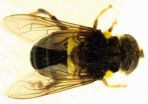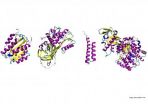(Press-News.org) It came out of Siberia, swirling winds over an area that covered almost the entire Arctic basin in the normally calm late summer. It came to be known as "The Great Arctic Cyclone of August 2012," and for some observers it suggested that the historic sea ice minimum may have been caused by a freak summer storm, rather than warming temperatures.
But new results from the University of Washington show that the August cyclone was not responsible for last year's record low for Arctic sea ice. The study was published online this week in Geophysical Research Letters.
"The effect is huge in the immediate aftermath of the cyclone, but after about two weeks the effect gets smaller," said lead author Jinlun Zhang, an oceanographer in the UW's Applied Physics Laboratory. "By September, most of the ice that melted would have melted with or without the cyclone."
Recent research showed that the Arctic cyclone was the most powerful ever seen during the month of August, and the 13th most powerful of all Arctic storms in more than three decades of satellite records.
"The storm was enormous," said co-author Axel Schweiger, a polar scientist in the Applied Physics Laboratory. "The impact on the ice was immediately obvious, but the question was whether the ice that went away during the storm would have melted anyway because it was thin to begin with."
The UW team performed the climate scientist's equivalent of a forensic exam: They ran a computer simulation of last summer's weather and compared it against a second scenario that was identical except that there was no cyclone.
Results showed the storm caused the sea ice to pass the previous record 10 days earlier in August than it would have otherwise, but only reduced the final September ice extent by 150,000 square kilometers (almost 60,000 square miles), less than a 5 percent difference. By comparison, the actual minimum ice extent was 18 percent less than the previous record set in 2007.
The study also revealed a surprising mechanism for the cyclone-related melting. Earlier discussions about the cyclone's effect had focused on winds breaking up the ice or driving ice floes into areas of warmer water. The results suggest that neither process led to much increase in melting.
Relatively recent research shows that in the summertime, thin ice and areas of open water allow sunlight to filter down to the water below. As a result, while a layer of ice-cold fresh water sits just beneath the sea ice, about 20 meters (65 feet) down there is a layer of denser, saltier water that has been gradually warmed by the sun's rays.
Blowing on polar water is less like blowing on a cup of tea and more like blowing on a layered cocktail. When the cyclone swept over the drifting ice floes, underside ridges churned up the water to bring sun-warmed seawater to the ice's bottom edge. The model suggests that during the cyclone there was a quadrupling of melting from below, and that this was the biggest cause for doubling ice loss during the three-day storm.
"We only looked at one big storm. If we want to understand how storms will affect the ice cover in the future we need understand the effect of storms in different conditions," said co-author Ron Lindsay.
More sunlight reaches the water in a year with unusually thin summer ice, such as 2012, so this process is a potential multiplier effect for sea-ice melting.
The results are of interest beyond understanding climate change. As sea ice thins and melts, economic and political concerns require better sea-ice forecasts to protect ships and instruments that might travel in those waters.
"One thing we are working on, and that needs to be included in future computer simulations, is how bigger waves created by wind blowing over more extensive open water help break up the sea ice into floes, and how these smaller floes respond to warm water," said co-author Mike Steele.
###
The research was funded by the National Science Foundation, the U.S. Office of Naval Research and NASA.
For more information, contact Schweiger at 206-543-1312 or axel@apl.washington.edu.
Cyclone did not cause 2012 record low for Arctic sea ice
2013-01-31
ELSE PRESS RELEASES FROM THIS DATE:
Electronic health records could help identify which patients most need ICU resources
2013-01-31
ANN ARBOR, Mich. — A national shortage of critical care physicians and beds means difficult decisions for healthcare professionals: how to determine which of the sickest patients are most in need of access to the intensive care unit.
What if patients' electronic health records could help a physician determine ICU admission by reliably calculating which patient had the highest risk of death?
Emerging health technologies – including reliable methods to rate the severity of a patient's condition – may provide powerful tools to efficiently use scarce and costly health resources, ...
International team observe 'hungry twin' stars gobbling their first meals
2013-01-31
AMHERST, Mass. – Just-forming stars, like growing babies, are always hungry and must "feed" on huge amounts of gas and dust from dense envelopes surrounding them at birth. Now a team of astronomers including Robert Gutermuth, a University of Massachusetts Amherst expert in imaging data from the Spitzer Space Telescope, reports observing an unusual "baby" star that periodically emits infrared light bursts, suggesting it may be twins, that is, a binary star. The discovery is reported this month in Nature.
The extremely young object, dubbed LRLL 54361, is about 100,000 years ...
Novel materials shake ship scum
2013-01-31
DURHAM, N.C. – Just as horses shake off pesky flies by twitching their skin, ships may soon be able to shed the unwanted accumulation of bacteria and other marine growth with the flick of a switch.
Duke University engineers have developed a material that can be applied like paint to the hull of a ship and will literally be able to dislodge bacteria, keeping it from accumulating on the ship's surface. This buildup on ships increases drag and reduces the energy efficiency of the vessel, as well as blocking or clogging undersea sensors.
The material works by physically ...
Biologistics: How fast do chemical trains move in living cells?
2013-01-31
The rate of chemical processes in cells is dictated by the speed of movement (diffusion) of molecules needed for a given reaction. Using a versatile method developed at the Institute of Physical Chemistry of the Polish Academy of Sciences in Warsaw, researchers were able to predict for the first time the diffusion coefficients of all proteins in Escherichia coli. The achievement is important not only for biologists and chemists, but also for... transport companies.
Understanding of chemical foundations of life requires knowledge about the rate of chemical reactions in ...
24 new species of flower fly have been found in Central and Southern America
2013-01-31
A team of scientists have described twenty four new species of dipterans belonging to Quichuana genus, of which only a further 24 species were known. The researchers, including two Spanish biologists, have been studying the forests of Central and Southern America for ten years and they have now published their results in the 'Zoological Journal of the Linnean Society'.
A ten-year study in forests of the American continent has resulted in the description of 24 new insect species from the Quichuana genus that are also known as 'flower flies'.
Up until now only a further ...
Rehabilitation therapies can lead to recovery from chronic fatigue syndrome
2013-01-31
Research led by Queen Mary, University of London, has shown that recovery from chronic fatigue syndrome (CFS) is possible for some patients, and has identified two treatments most likely to lead to recovery.
The latest results from the PACE trial* show that cognitive behaviour therapy (CBT) and graded exercise therapy (GET), as supplements to specialist medical care, increase the likelihood of recovery from CFS three-fold compared to other treatments studied. The trial, carried out in collaboration with researchers from King's College London, the University of Oxford ...
The humble 'virtual chimney' fences that could reduce the impact of airport pollution
2013-01-31
Simple 'blast' fences called baffles could deliver improvements in air quality for people living near airports, new research has found.
Placed behind a runway, the baffles could serve as a 'virtual chimney', funnelling emissions from aircraft engines upwards where they can disperse more effectively, thereby reducing the environmental impact on people living nearby.
Prototype baffles have been tested by a team of researchers from Manchester Metropolitan University, Cranfield University, University of Southampton and the University of Cambridge, with funding from the ...
Disulfiram: New support for an old addiction drug
2013-01-31
Philadelphia, PA, January 31, 2013 – Disulfiram was the first medication approved for the treatment of alcoholism over 50 years ago. It works, at least in part, by preventing the metabolism of an alcohol by-product, acetaldehyde. High levels of acetaldehyde in the body quickly cause unpleasant symptoms, including nausea, vomiting, headache, and accelerated heart rate. Thus, disulfiram provides a very strong incentive to avoid drinking.
Beginning in the late 1990s, a series of studies conducted at Yale University found that disulfiram reduced the consumption of cocaine, ...
Protein origami: Quick folders are the best
2013-01-31
Proteins are elementary building blocks of life. They often perform vital functions. In order to become active, proteins have to fold into three-dimensional structures. Misfolding of proteins leads to diseases such as Alzheimer's or Creutzfeld-Jakob. So which strategies did nature develop over the course of evolution to improve protein folding?
To examine this question, the chemist Dr. Frauke Gräter (Heidelberg Institute for Theoretical Studies) looked far back into the history of the Earth. Together with her colleague Prof. Gustavo Caetano-Anolles at the University of ...
A possible answer for protection against chemical/biological agents, fuel leaks, and coffee stains
2013-01-31
A recent discovery funded by the Air Force Office of Scientific Research (AFOSR) may very well lead to a process that not only benefits every uniformed service member of the Department of Defense, but everyone else as well: protection from Chemical/Biological agents, to self-cleaning apparel, to effortless thermal management, to fuel purification as well as enhanced control of leaks—especially oil and fuels.
In 2006, AFOSR Program Manager Dr. Charles Lee funded Professor Gareth McKinley at the Massachusetts Institute of Technology exploring nanocomposite technology ...




